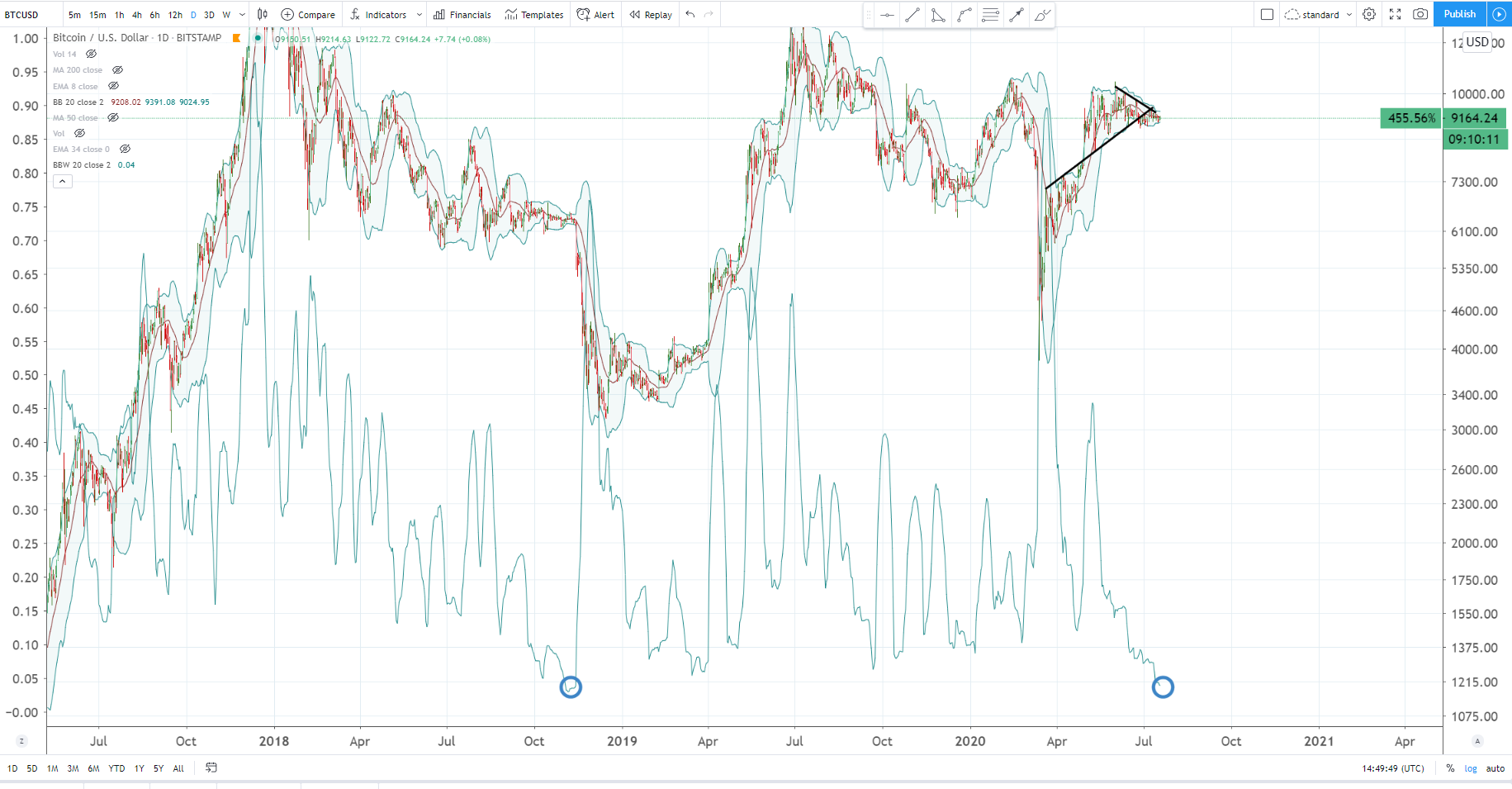Shunning Bitcoin’s lack of trend, altcoins have seen extreme volatility over recent weeks. Take the example of Chainlink (LINK), a community-favorite altcoin that is up by around 450% since the March lows. Although it has just recently set a new all-time high, the asset has seen multiple days where it swings back and forth between resistance and support levels.
Crucial technical indicators, though, show that Bitcoin may finally see some much-needed volatility.
Related Reading: Crypto Tidbits: Twitter’s “Bitcoin Scam,” Elon Musk & Dogecoin, Institutions Want BTC & ETH
Bitcoin Could Soon See Strong Volatility
A cryptocurrency trader recently noted that the width of Bitcoin’s Bollinger Bands is at lows not seen since October/November 2018. “Daily BBs have not been this tight since October of 2018 – I hope you have your popcorn ready,” he explained, referencing the chart below.
The Bollinger Bands is a technical indicator that “characterizes the prices and volatility over time of a financial instrument or commodity,” as Wikipedia explains. They often tighten just before an asset undergoes a breakout, as markets often undergo consolidation before expansion.
This concept applies to Bitcoin. As can be seen in the trader’s chart below, every time Bitcoin saw a major bout of price action, the width of the indicator tightened greatly.
Macro BTC price chart with Bollinger Bands and Bollinger Bands width overlayed from trader "Cheds" (@Bigcheds on Twitter). Chart from TradingView.com
This latest analysis comes shortly after Josh Rager, the co-founder of Blockroots and a noted crypto trader, said that the historical volatility index of the asset has reached ~40.
“Bitcoin historical volatility (HV) nearing 40. $BTC volatility this low has historically led to major price action between 30% to 60% movement in the following weeks From current price: 30% move to the upside is $12,200, and a 30% move to the downside is $6,500. Put your seatbelt on”.
Related Reading: BTC Just Confirmed a Signal That Preceded Historical 5,000% Rallies
All Eyes on Stocks
Many analysts in the crypto space have opinions on which way the consolidation will break. Bloomberg senior commodity analyst Mike McGlone, for instance, recently wrote:
“Volatility should continue declining as Bitcoin extends its transition to the crypto equivalent of gold from a highly speculative asset, yet we expect recent compression to be resolved via higher prices.”
#Bitcoin Blahs? Benchmark #Crypto Looked Similar Before Past Gains —
Volatility should continue declining as Bitcoin extends its transition to the crypto equivalent of gold from a highly speculative asset, yet we expect recent compression to be resolved via higher prices. pic.twitter.com/XbIMv5AYAf— Mike McGlone (@mikemcglone11) July 2, 2020
But, which way this consolidation resolves may be dependent on the stock market.
As analysts on Wall Street and in crypto have found, a strong correlation has formed between the S&P 500 and Bitcoin over recent months. This suggests that should the stock market see a breakout, BTC will follow.
Unfortunately for cryptocurrency bulls, some analysts are expecting a correction in the shares of companies as we enter the earnings season for Q2 2020.
Featured Image from DepositPhotos Price tags: xbtusd, btcusd, btcusdt Charts from TradingView.com "Have Your Popcorn Ready": Bitcoin Volatility Is At Extreme Lows

